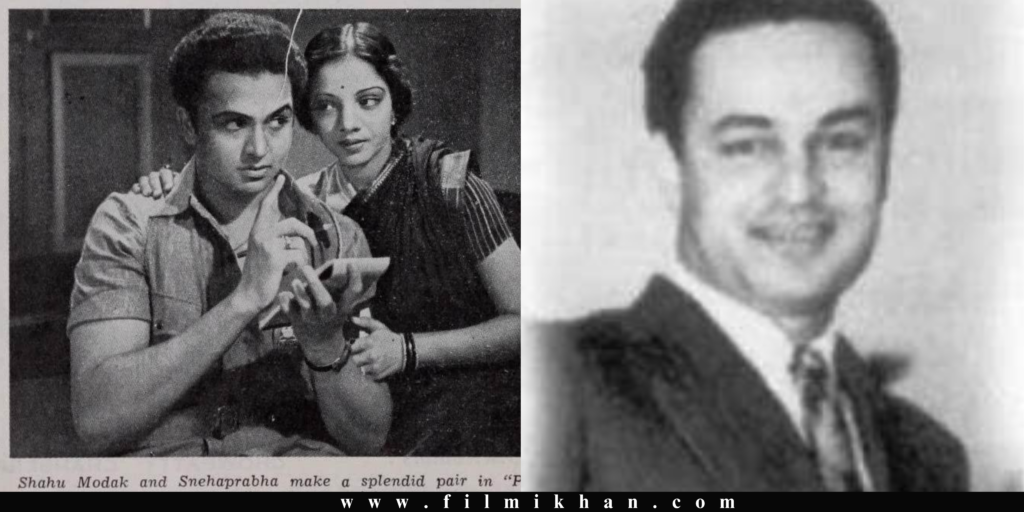
Shahu Modak, born on April 25, 1918, in Kolkata. was a distinguished figure in the realm of Indian cinema. His journey began amidst the cultural hubbub of Bengal, where he developed a keen interest in acting and theatre from a young age. His family, supportive of his artistic inclinations, encouraged him to pursue his passion.
1930 and 1950 was a time when there was a strong trend of mythological films in Hindi cinema. God’s stories were played extensively on screen. There is a wealth of stories in the pastimes of Shri Krishna. There was one such artist in Hindi films, who was seen the most in the form of Shri Krishna. This actor was Shahu Modak. He was born in a Christian family. He played Shri Krishna in about 30 films in his life. Shahu Modak was first selected for the role of Bal Shri Krishna by Bhalji Pendharkar, when he was studying in school. While directing Pune’s Saraswati Cinetone film ‘Shyam Sundar’ (1932), he was selected for the role of Bal Shri Krishna. This film was a super hit on box-office. This was the first film to run for 25 consecutive weeks in the same talkie. After that, Shahu Modak became the first choice of producers for films made on Krishna.
Shahu Modak became so famous in the form of Shri Krishna that the colourful calendars printed at that time had the picture of Shahu Modak in the form of Krishna. Shahu Modak was born in a Christian family of Ahmednagar (Maharashtra). Shahu Modak, who was most famous in his era as Shri Krishna, has a very important record in his name. He is the first hero of Hindi films, who played a double role in a film. The film was Awara Shehzada. Shahu Modak was a famous artist of Hindi as well as Marathi films.

After child roles, Shahu started appearing in films as a young artist. In the days when Shahu was doing films, it was necessary for any hero to be a singer. In such a situation, Shahu Modak also learned classical music. He also made his place as a good singer. Sevasadan, Hind Mahila and Honhar were his successful films. Shahu Modak worked with all the eminent Hindi and Marathi film directors of his time.
As he grew up, Shahu Modak developed interest in astrology and gradually he immersed himself in it and became a scholar. His wife Pratibha Shahu has written in her book, Shahu Modak: Pravas Ek Dev Manasa Cha, that when Shahu Modak turned 75 on 25 April 1993, he announced his death and said that now I will live for 18 more days. This happened and on 11 May 1993 he said goodbye to this world.
Throughout his illustrious career, Modak delivered several memorable performances that left an indelible mark on Indian cinema. His portrayal of characters in films like Awara Shahzada (1932), Nand Ke Lala (1934), Hind Mahila (1936), Aadmi (1939), Sant Dnyaneshwar (1940), Apna Paraya (1942), Dulhan (1943), Ladai Ke Bad (1943), Kanoon (1943), Geet (1944), Meghdoot (1945), Shri Krishnarjun Yuddha (1945), Uttara Abhimanyu (1946), Seedha Rasta (1947), Mandir (1948), Nar Narayan (1949), Sant Namdev (1949), Veer Ghatotkach (1949), Bhagwan Shri Krishna, Bhishma Pratigya, Shri Ram Avtar, Vatsal Kalyanam (1950), Jai Mahakali, Vitthal Rakhumai, Hi Mazi Lakshmi, Shri Krishna Satyabhama (1951), Bhakta Puran, Draupadi Vastra Haran (1952), Bhakt Dhruv Kumar (1964), Narad Leela (1972), Jai Bajrang Bali (1976), Jai Ambe Maa (1977) and Krishna Krishna (1986) captivated audiences and critics alike, earning him widespread acclaim and numerous accolades.
Beyond his contributions to cinema, Shahu Modak’s influence extended to the realm of social change. He used his platform to address pertinent issues through his work, advocating for societal progress and reform. His commitment to using art as a catalyst for change left an enduring legacy, inspiring future generations of actors and filmmakers to use their craft as a means of enlightenment and empowerment.
Despite his busy schedule, Shahu Modak remained grounded and dedicated to his craft. He was known for his humility, generosity, and unwavering passion for acting. His love for the arts extended beyond the screen, encompassing literature, music, and various forms of creative expression.
Shahu Modak’s journey is a testament to the transformative power of art and the enduring impact of talent, dedication, and passion. His contributions to Indian cinema have left an indelible mark, earning him a revered place in the annals of film history. As audiences continue to revisit his timeless performances, Sahoo Modak’s legacy lives on, reminding us of the profound influence of storytelling and the enduring spirit of creativity.








One Comment